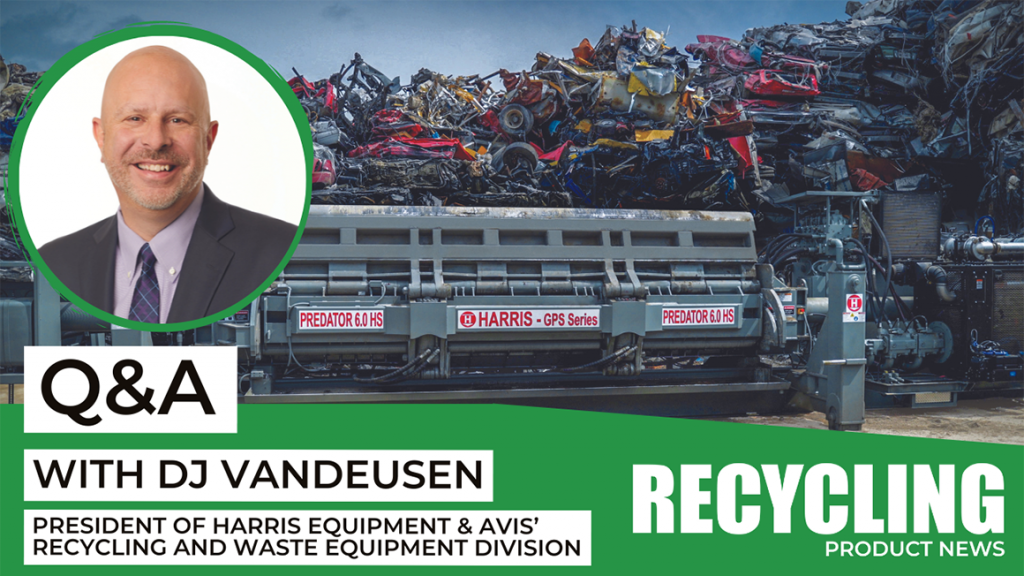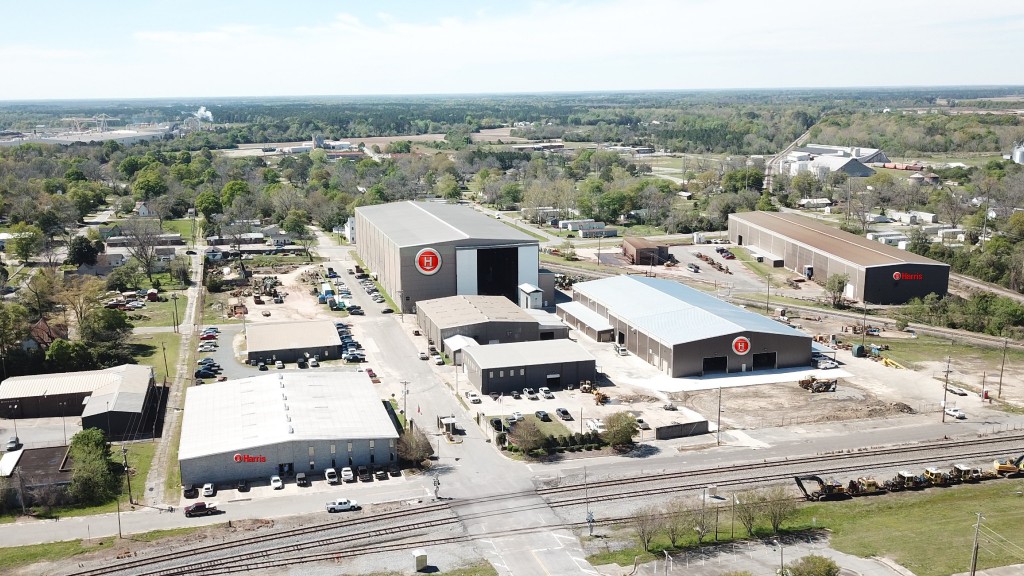Q & A: DJ VanDeusen on collaboration, industry challenges, and the evolving role of balers

In an age where sustainable practices and environmental responsibility are paramount, collaboration between industry leaders is playing a crucial role in fostering innovation and propelling the recycling industry forward. Back in February, Harris Equipment, American Baler, and International Baler joined forces to form the AVIS Recycling and Waste Equipment Division, leveraging their collective expertise and resources to tackle the challenges faced by the recycling and waste sector.
I connected with DJ VanDeusen, president of Harris Equipment and AVIS' Recycling and Waste Equipment Division, to discuss supply chain issues, the evolving role of balers in waste management initiatives, and his vision for the future.
Slone Fox: Can you talk a bit about how the AVIS Recycling and Waste Equipment Division came to be?
DJ VanDeusen: Greg King served as the president of Harris prior to being named the CEO of Avis Industrial. I was fortunate enough to be selected for the leadership role at Harris just over two years ago, and that led to Greg and I discussing the fact that there were three baler companies – Harris, American Baler, and International Baler – that were part of the Avis portfolio of companies, yet we acted like competitors and completely independent businesses in the industry. When Avis completed the acquisition of the remaining shares of International Baler last summer, the discussions on how to bring the three companies together became a lot more tangible.
SF: What can we look forward to seeing from this new division?
DV: We're just getting started with the alignment and integration of the three businesses, and our early focus is on procurement synergies, production capabilities, product line coverage and redundancies, and commercial go-to-market strategies. As you can imagine with three companies that have been in business – and in competition – for a combined 289 years, there's a lot of well-earned pride in how each business operates and has been successful over the long haul. Our goal is to honour the legacy that each business brings, leverage the competitive advantages that each business has established in the industry, and provide a depth and breadth of compaction and size reduction products across our three brands that is unmatched.
We believe that there's an opportunity to provide even greater service coverage for our installed base through the optimization of the field technician resources we have within the three companies, and the distributor network that is such a critical part of our success. We're confident we'll be able to provide shorter lead times on new units and mission-critical maintenance parts by redistributing and duplicating key production activities that take place across our four manufacturing locations.
The organization that will help guide the division forward is now in place with manufacturing, procurement, and sales integration roles filled and critical functional leadership positions named. We were proud to have all three businesses together under one trade show roof at WasteExpo back in May as the first steps in the integration process.
SF: What are some of the key challenges that the baler industry faces today, and how is Harris Equipment addressing these challenges? What more needs to be done as an industry?
DV: We might need a special edition of Recycling Product News to cover all of the challenges the baler industry faces today. With that said, it's a great time to be in the business as demand for size reduction and compaction equipment has been very strong over the last 24 months, and the generation of waste and recyclable materials continues to increase each year. The single largest challenge facing our industry today is the lack of skilled tradespeople for heavy industrial manufacturing – welders, fabricators, and machinists, to name a few. It's not just the lack of those resources today that is a concern, but the fact that the demographics of production employees today suggest that this gap is only going to widen as skilled resources approach retirement with a pipeline entering the workforce at a much smaller rate. Support and funding for local and regional trade schools is absolutely critical for attracting energetic young men and women looking for a career path that does not include the college route. This has to be coupled with clear messaging to high school students that learning a trade is not somehow a lesser success and achievement than pursuing a college degree.
Private industry plays a role in this by taking the initiative to establish true apprentice program opportunities for early career hires that include broad, hands-on job training and educational skills and leadership training to position these apprentices for success beyond the initial job requirements. At Harris, we have made a significant investment in education and training through the advent of our recognized apprentice program, the purposeful development of Harris University, and the engagement of time and resources with the high schools and technical schools in our communities. We simply have to make this investment and get it right in order to change the downward trajectory of the talent pipeline.
SF: How do you see the role of balers evolving in the broader context of waste management and recycling initiatives, especially relating to things such as EPR?
DV: The more introductions of successful waste management and recycling initiatives, the better for the baler industry if those initiatives lead to more material being captured and reused. We also support the activities underway to drive a more circular economy and reduce unnecessary packaging for consumer and industrial goods - even if this results in there being less material to be recovered tomorrow. Our purpose has always been to allow for reusable material to be moved simply and cost-effectively from the collector of the material to the re-user of the material.
In order for recycling initiatives to sustainably work, there has to be an economic return for the recycler and the recyclable material consumer. Baling equipment is a key element of that financial equation regarding transport costs. I continue to believe that baler manufacturers need to have a seat at the table for the discussions around recycling and packaging initiatives as key stakeholders in the process, and to ensure that our innovation journey is aligned with those initiatives and how the recycling and waste stream may change as a result.
SF: Can you touch on the supply chain issues of the last few years? In your opinion, is there an end in sight or do you see this continuing?
DV: Input cost inflation has been the single largest challenge for baler manufacturers as steel experienced unprecedented price increases from mid-2020 through mid-2022. While prices have somewhat stabilized over the past nine months, there are no solid indicators of any near-term steep price corrections.
Overall steel demand declined in 2022 as the post-pandemic rebound appears to have peaked, and the fears of a pending recession coupled with interest rate hikes may slow investment in construction and heavy industrial equipment. But despite these impacts, most forecasts expect there to be a modest increase in steel demand over the coming 24 months as the global economy continues to recover post-pandemic. All of this has resulted in necessary product price increases despite all efforts to minimize the effect on product cost through strategic sourcing, increased inventory levels, and product redesign.
This is not to say that supply chain issues have been limited to solely steel and steel component inflation. The shipping disruptions that wreaked havoc with production schedules in 2021-2022 have, for the most part, subsided, but there are indications that shipping companies are scaling back on planned voyages to attempt to prop up the sagging shipping rates.
Finally, the shortage of available electronic components such as programmable logic controllers, due in part to the semiconductor shortage, has made dramatically expanding the supplier base imperative to meeting new unit and maintenance schedules. These supply chain disruptions have been more pronounced over the past three years, but our businesses always have to be prepared with business plans for the disruptions that are part of the everyday environment we operate in.
SF: Are there any upcoming developments or trends in the industry that you are particularly excited about?
DV: I expect that the trend for consolidation in the recycling and waste industry, especially on the post-collection side, will continue as the aforementioned labour shortages and supply chain disruptions have made it increasingly more difficult for the smaller, independent operators to remain competitive. I'm hopeful that this consolidation will lead to the innovation and modernization of collection and sorting systems.
The ongoing push for effective and sustainable municipal recycling programs should serve to increase the amount of recyclable material that is being collected, and as a manufacturer of the machine that is the heartbeat of a recycling centre, that is music to our ears.
Lastly, as technology allows for the recovery of a higher amount of material found in single-stream systems, and for improved methods of handling and separating contaminants, we fully expect the demand for baling and compaction equipment to remain strong.
SF: What is your vision for the future of Harris Equipment, and what are the key areas of focus for you moving forward?
DV: We announced a fundamental change in how we view the future opportunities for Harris with the announcement of the Recycling & Waste Equipment Division in February. Being able to bring together the best of what Harris Equipment, American Baler Company, and International Baler Corporation have to offer – our people, our products, our processes – will shape the future of all three companies in a way never before examined. It's important that we don't lose sight of the legacy that the combined 289 years in business has built, and that we cherish the brands that the industry relies on for its size reduction and compaction needs.
Innovation, performance excellence, and product line optimization are not meant to minimize what has been accomplished over the history of the businesses, but are to ensure that these businesses, collectively, further strengthen their industry leadership position. We intend to be leaders in training and development in rebuilding the skilled trade workforce through our direct investment in Harris programs, as well as through deep-seated community involvement. We intend to develop products that are focused on energy efficiency, ease of maintenance, heightened safety measures, and data collection. We intend to offer an unmatched depth and breadth of products for size reduction and compaction, the largest field service network available in the U.S., and reduce lead times for mission-critical parts and cylinders to support the ongoing needs of our collective installed base.
Growth will come as a result of us doing what we intend to do. Our motto at Harris is simple: Be Harris – by being optimistic, engaged, and motivated; by being dedicated, accountable, and innovative; by being cooperative, responsible, and sincere.



